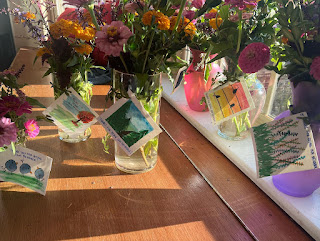"Idea Friendly Method" Helps Overcome 80/20 Rule with Volunteers in Neighborhood
Becky McCray, creator of the "Idea Friendly Method," was the speaker for University of Missouri Extension's Neighboring 101 class on Jan. 20.
"The idea-friendly approach is different from the old way of organizing events where we would create committees, develop ideas, and hope that someone shows up to participate," said McCray. "Instead of obsessing about changing other people, we focus on taking our actions."
This approach also helps overcome the old 80/20 rule where you are at the top level for excitement, and no one else probably has the same level of enthusiasm.
"So, it becomes frustrating when you think no one is as excited about this as I am. If this were a committee, you would cut these people off because they won't come to meetings," said McCray.
The new way of looking at this is that the leader's enthusiasm is actually at the bottom of the curve, then other people add on with their input or involvement.
"Whether they help do an event, or just like a post online, they are adding to the value of this project and building on top of my enthusiasm," said McCray.
McCray's "idea friendly method" has three basic steps for planning community or neighborhood events or projects.
1. Gather your crowd: begin with your big goal.
"The old way was to form and assign people to committees. The new way is to plant a flag with a big idea or goal to draw people in to begin a part of it. Focus on becoming a movement that people can get behind," said McCray.
2. Build your connections: create a network for people that support the idea.
"New way to
build connections is to build the event together. Ask others to take on a role.
Get people involved that will bring their friends and connections. This also builds social capital," said McCray.
3. Take Small Steps: complete a miniature version of the goal first
"The old way is to hold a meeting and assign tasks. The new way is to approach the project as a temporary experiment and begin with a small event and then grow it," said McCray.
Scientist Steve Maier said:
"Significant change will occur with minimal force if applied over an
extended period of time." Each of us taking small steps over time leads to
big changes!
MEASURING EXCITEMENT
The old 80/20 rule diagram is included at the top of this blog. Let me explain what you are seeing as it relates to neighboring.
Here I am at the top left of the chart for my
excitement level; no one else in the neighborhood probably has the same enthusiasm for the topic or project. So, it becomes
frustrating when you think no one is as excited about this as I am. If this was
a committee, you would cut these people off because they won’t come to meetings.
The idea-friendly approach is different from the old way of organizing events where we would create committees, develop ideas and hope that someone shows up to participate. Instead, we clearly state our goal or idea with the idea-friendly method and gather our crowd of like-minded individuals. Then we build connections with those who might want to be involved as speakers or partners or other ways that someone can contribute.
HERE IS AN EXAMPLE
Stores owners in Pullman, Washington had a problem: dirty sidewalks after storms. The business owners met to discuss and hoped the city would clean them. But people couldn't agree on a work date, and not everyone thought it was important.
If Willow had tried to get everyone to change their minds, forget doing a cleanup day, and sweep their own sidewalks instead, and then persuade the city to change their street sweeper work schedule, they would all have resisted at every step. Willow didn't try to change their minds.






Comments
Post a Comment